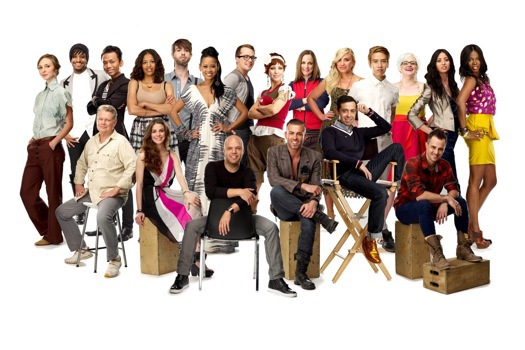
Project Runway Season 9 cast. Photo courtesy Lifetime
I’m generally not a fan of “reality” television, with the exception of programs in which the objective is to create something as opposed to embarrass someone. Project Runway is one of those exceptional shows, and I confess that at least part of my interest in it stems from nostalgia for many years spent in design school, charretting late into the night, getting punchy with my classmates.
I view Project Runway as the literal classroom that it is, mainly because each episode provides rich professional practice lessons for designers. Season number nine premieres this evening, and I cannot wait to see the latest batch of creative projects dreamed up by the producers and the corresponding interpersonal challenges they spawn.
For example, a wrench that often gets thrown into the design process is to tell the competitors that they will be paired with one of their colleagues to complete that week’s project. As observers of the cringe-inducing verbal barbs and eye-rolls that result when the rivals-turned-comrades try to produce something fabulous together, we recognize the difficulty of forcing two egos to work as one. We may even feel sorry for them, asking ourselves why a program that is about discovering individual artistic expression is smothering all that talent for the sake of a plot twist.
The truth is that “design” — indeed, any creative endeavor — that achieves commercial success is almost always the result of some kind of collaborative effort. It may not always be collaboration between design minds, although that is how many fashion houses actually operate. Collaboration across multiple disciplines and functions — design, business strategy, engineering, manufacturing, marketing, etc. — is critical to “making it work” (to paraphrase the program’s mentor, Tim Gunn). So we see that during the episode’s final critique, the Project Runway judges’ commentary inevitably addresses the designers’ team dynamics in addition to the fashions that were produced for the runway.
Lest anyone think that pairing up designers in a design competition is just another way to stir up conflict in the workroom in order to create compelling entertainment, it’s important to remember that collaboration among peers — even between rivals — is an important element in the management of a creative enterprise. And it’s probably one of the few times that “reality” is constructively introduced into reality television.
An additional lesson offered by Project Runway concerns the designer-client relationship. This is one of the most difficult aspects of professional practice for any designer to navigate, and I can tell you that it’s not taught in design school — at least not when I was in design school.
In an episode from a previous season, the Project Runway contestants were each paired with a new divorcee who hoped to have her wedding gown transformed into a garment suitable for her new life (other seasons have offered alternative versions of this same challenge — asking the designers to re-construct clothes belonging to women who had lost a great deal of weight, for example). After the euphoria of the initial meeting, when designer and client equally anticipate the potential of what could be, difficulties in the relationship begin to arise. Tensions mount between the expression of artistic vision (the reason the designer was hired) and the fulfillment of client needs (also the reason the designer was hired). By the second or third meeting to discuss the status of the project, both client and designer are often wishing they were working with someone else.
To the viewing audience it would seem that designers are happiest when provided minimal direction and then released to go off and work, in their own time and in their own way, engaging the client only when the project is ready for the big “tah-dah” moment. At which point the client would be floored by the designer’s brilliance and fully satisfied with the results.
Nice — but a fantasy, for sure. Clients do get involved. They provide feedback and suggestions or requests, sometimes getting so caught up in the fun of designing themselves that they discover a latent desire to more regularly exercise their own right brain. And why shouldn’t they, when they are funding the project (at least in the non-televised version)?
So who should be taking the lead here? Who needs to be pleased? Designers seek to express their creative identity through the product, and the fashions produced for Project Runway are often a one-off that only need to express the style of a unique client. But this is a model more reminiscent of a time like the Renaissance, when clients were devoted long-standing patrons of individual artisans who worked directly for them.
The reality is that most designers seek commercial success, which requires a one-to-many (not just a one-to-one) sensibility. From architecture to product development, the outputs of the design process must have wide public usefulness and appeal. In this case the end consumer is not physically present in the design studio, in the dual role as client. Project Runway offered up this scenario when Macy’s asked the designers to create an addition to one of their signature product lines. With no obvious means of connecting with the prospective consumer for either inspiration or feedback, the designers were left to their own imaginations. The client played no role in aiding in their interpretation, though presumably it could have.
The bottom line is that designers and clients need each other, and each must take active responsibility for making a project successful. Designers must balance the confidence to express themselves with the humility to address the needs of others. And clients must develop ways to stay productively and knowledgably involved throughout the process.
